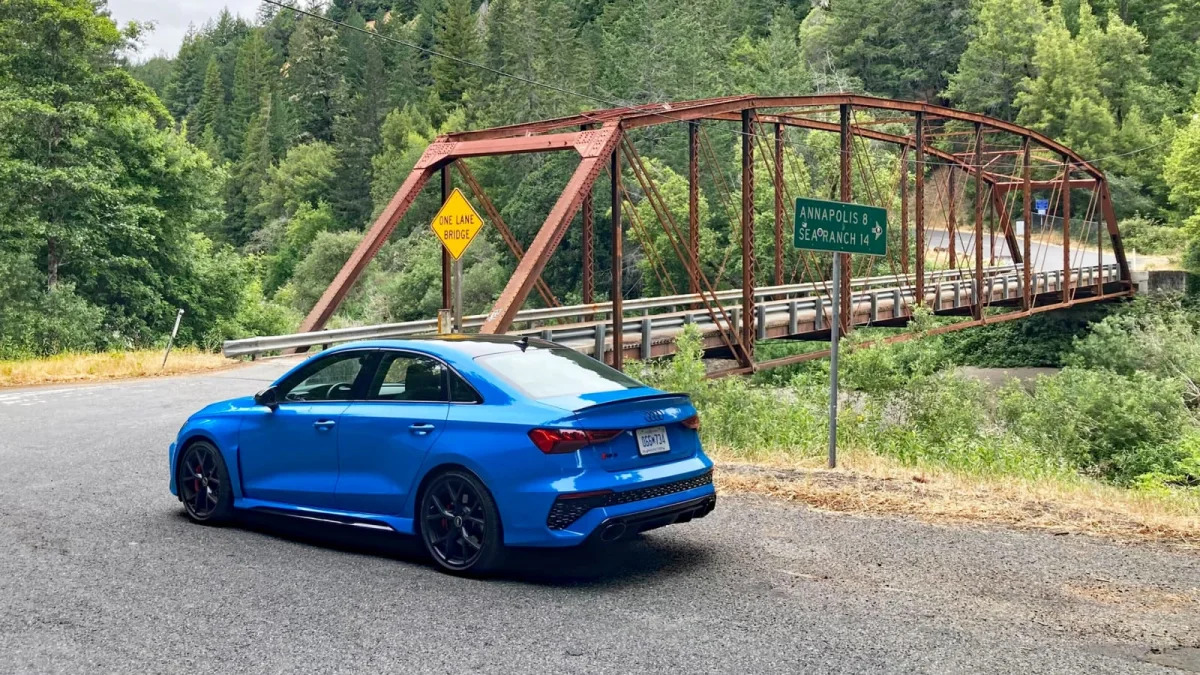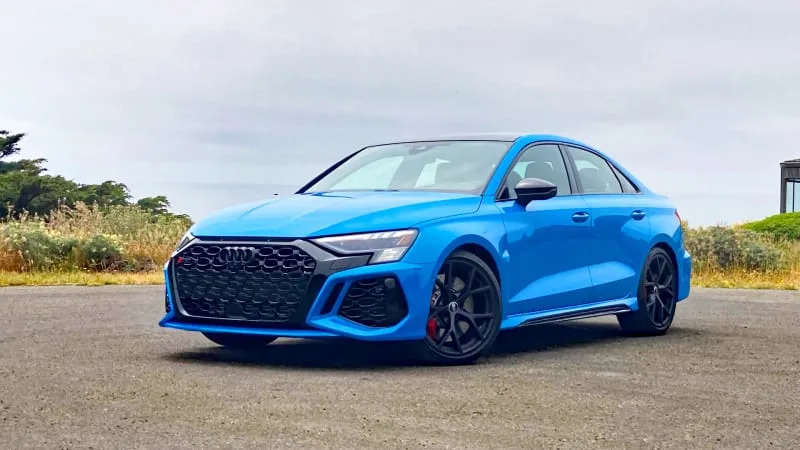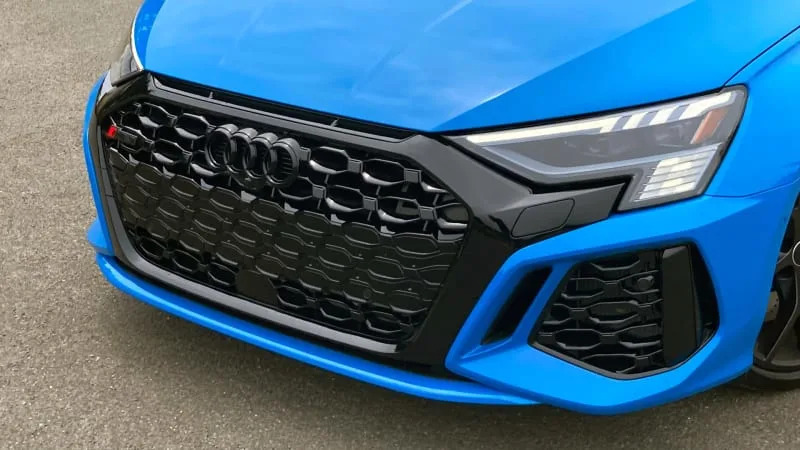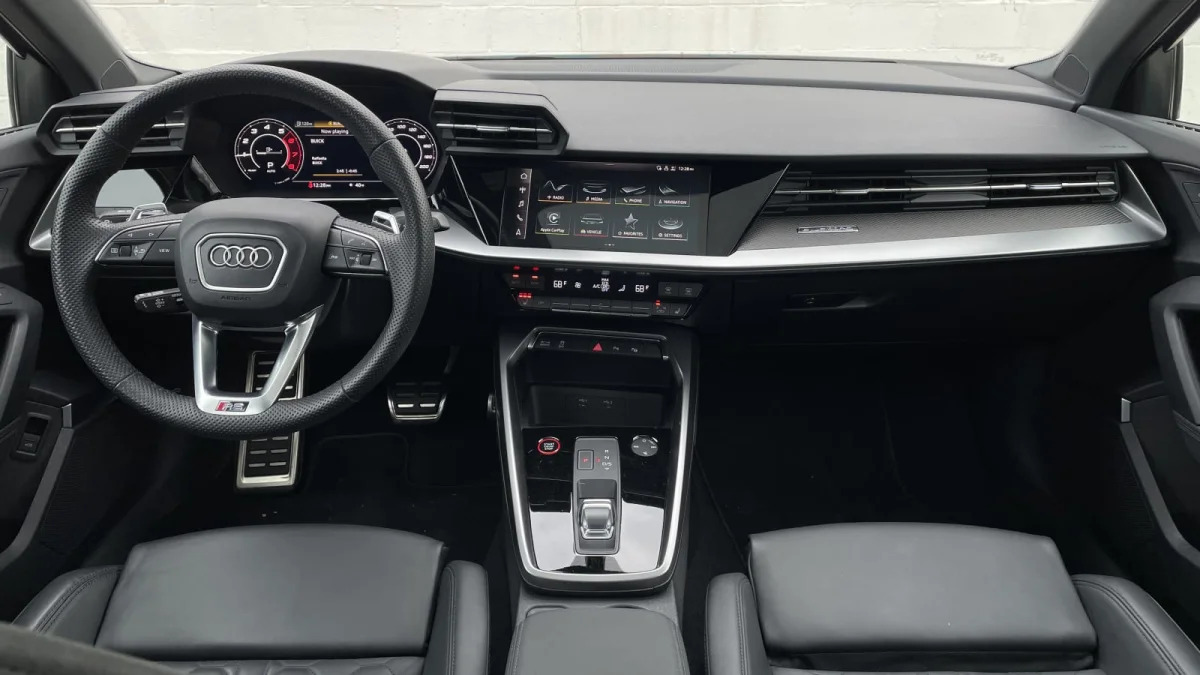SANTA ROSA, Calif. – There were three possible routes ahead of me. One headed back in the direction I came, along the slow-moving coastal highway past a heavy construction zone where I already sat not moving for seemingly ever. No thanks. Option 2 kept going up the coast until turning inland toward a reasonably fun road I recently sampled, but we want to make it to Coppola Winery by 3 p.m. and we’d be about 45 minutes late if we took that. Option 3 was seemingly a straight shot from Sea Ranch on the coast to Coppola in Sonoma County that would theoretically get us there on time, according to Google. Great! Thing is, this route involving “Skaggs Springs Road” looked extremely squiggly and definitely not a major thoroughfare. Google can’t always tell the difference. Visions of being eaten by a bear after a tire blows on some unmaintained logging road flash in my head.
Ah, what the hell, at least I’d have some fun before becoming lunch.
The 2023 Audi RS 3 is a firecracker of a little car dripping in character, and if you’re going to find yourself on a tight, technical, one-and-a-halfish-lane road through a coastal redwood forest, there actually aren’t many that would be better. Let’s start with its size, which may be small by today’s standard, but most dimensions are virtually identical to the first Audi A4 (B5). That car still turns my head after 25 years and sprang from an era before sport sedans ballooned in size thanks to focus groups wishing for palatial back seats. In other words, the RS 3 feels just right behind the wheel. There’s no fat. It’s practical enough as a sedan, but it’s also not trying to be a Camry.
It happily danced around huge chunks of missing asphalt and whipped itself around narrow hairpins bookended by redwood trunks. Aiding in that whipping is the RS Torque Splitter: two electronically controlled multi-plate clutches, one for each of the rear driveshafts, which allows for fully variable torque distribution between the rear wheels. There are two settings for this. One that reduces understeer by sending torque to the outside wheel, otherwise known as torque vectoring, that we’re already familiar with in various Acuras and elsewhere. The other is dubbed RS Torque Rear, which sends more power rearward to induce controlled oversteer, otherwise known as a drift mode. My wife was in the car, I didn’t use that. The scary, narrow road through the empty forest was enough of an ask.
Yet, when the pavement proved sound enough, adding torque vectoring to such compact dimensions was a revelation. It feels much more natural and cohesive with the rest of the chassis, as opposed to using it to counteract some inherent flaw. This car is just definitively tossable.
Part of that is the RS-specific work done to that chassis, including springs, adaptive dampers, sway bar and a ride height lowered by 25 mm versus the standard A3. Summer tires wrap around 19-inch wheels. The resulting ride is well north of “firm,” and while perfectly acceptable to that point in the drive, the broken pavement on the earliest portion of Skaggs Springs Road was sending the needle past firm toward crashy and then comical.
“What have I done?” I started to ponder, looking down at the car’s navigation system, realizing it could actually get worse from here. Besides jarring impacts, I also had to worry about the tires. There hadn’t been cell service for many miles (hence the in-car nav versus Google Maps), but there were, I assume, bears.

Thankfully, though, the road improved. The pavement became contiguous, and the road widened after encountering the first truck coming in the opposite direction. Eventually, the greenery started to clear enough to see we were at the head of a valley; one where the west wall is dense rainforest and the east wall is typical Californian beige brush dotted by bushy green oaks. It’s like we reached a climatic border. The road changed again, too, with faster-sweeping turns and longer straightaways, meaning the RS 3’s little monster under the hood could get out and stretch its legs.
The 2.5-liter has five cylinders, which is always awesome, due to both rarity and the uniquely growly engine note that’s quite obviously neither an inline-four nor inline-six. It pumps out 401 horsepower and 369 pound-feet of torque, which (checks my notes) is indeed just a wee bit more than an A4/S4 from 25 years ago. It’ll hit 60 mph in 3.6 seconds, and apart from the swift boot to the chest it’ll dole out when you lay into it, the snarling exhaust is addictive. It just sounds so cool, if a tad angry. The RS 3 is the automotive equivalent of a small dog at the end of a rope.
It’s more pug than poochon, though, because I can’t say this latest RS 3 is a particularly good-looking car. I just don’t understand the all-black front end Audi customers keep fawning over (their eagerness to dole out extra money for black plastic appearance packages is why Audi designers begrudgingly keep pushing the envelope in this direction), and the RS-specific body kit looks awfully tacked on and makes the car look bottom heavy. Frankly, the old RS3 was the more handsome car inside and out, but then again, this one is more distinctive and perhaps all those sharp angles and the big, angry, blacked-out face are more in keeping with the car’s character.



Even if the aesthetics aren’t to my taste, I’m ultimately impressed by the cabin’s quality. There are some cheaper plastics on the center console, but otherwise, this is a junior Audi cabin, not a discount one. The Virtual Cockpit instrument panel is the same unit found in the 2024 RS 6 Avant I drove two days prior, and while the RS 3 lacks that car’s second touchscreen for the climate controls and other functions, the physical buttons in their place are arguably better. Or, at the very least, no loss.
The seats provided abundant adjustment and flawless comfort throughout this drive and the days that followed around Sonoma County and Napa Valley. Space is perfect for a couple on vacation. There’s a scarcity of legroom behind my seat (I’m 6-foot-3), but to be clear, that is not a complaint. It’s a reality I’m totally fine with. Again, please don’t make this car bigger. My 3-year-old could still have come along if we had invited him, making the RS 3 a viable fun choice in a family’s two-car garage. The trunk is certainly on the small side, making me yearn fruitlessly for the RS 3 Sportback sold in Europe, but I did appreciate the cargo net included with this test car that prevented our luggage from Plinko-ing around through all those rainforest hairpins.
All told, the RS 3 was a more comfortable car than I was expecting, even on the questionably paved portions of the journey. It was also just as fun as I was expecting, and the adventure on Skaggs Springs Road was exactly what was needed to showcase its talents. I’d say the road wasn’t that bad, but then again, it sure seems like I also had the perfect car for it. OK, so maybe some more sidewall would’ve been nice, but ultimately, it turns out that sometimes the most direct route can be the most fun one. And hey, I didn’t get eaten.
